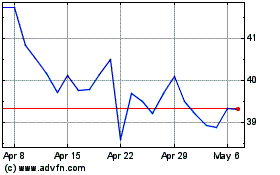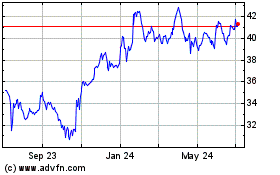Altice Plans Fiber Upgrade That Could Leave Rivals in the Dust
November 30 2016 - 11:10AM
Dow Jones News
Altice USA, the fourth largest U.S. cable operator, said it
plans to convert its entire network into an ultrafast
fiber-to-the-home network capable of 10 gigabits-per-second speeds
within the next five years, a bold plan that takes aim at the
company's fierce rival, Verizon Communications Inc.'s Fios.
With a 1 gbps connection, a customer can download a
high-definition movie in about 30 to 40 seconds. A 10 gbps
connection would download the movie in just a few seconds. With a
50 megabits-per-second Verizon Fios connection, it would take about
14 minutes.
Altice's announcement marks the most ambitious fiber-to-the-home
rollout yet from a major U.S. cable operator. The European telecom
group earlier this year closed a deal to buy Cablevision Systems
Corp., a longtime New York cable operator, and last year bought
Suddenlink Communications, which serves customers in more rural
markets. Altice USA has 4.6 million home and business customers in
20 states.
Altice is departing from the approach taken by its industry
peers. Other cable operators, including Comcast Corp., have
extended high-capacity fiber lines all the way to homes in only
select "greenfield" markets and are largely banking on a new cable
technology called "DOCSIS 3.1" to deploy gigabit speeds over their
existing networks. Traditionally in cable networks, fiber only runs
to a central point in local areas, with lower-capacity coaxial
cables wired to each home.
Deploying DOCSIS 3.1 avoids the hassle and investment associated
with wiring fiber all the way to homes, though operators still need
to make substantial investments in back-end infrastructure and
deploy new customer modems to reach gigabit speeds. Comcast has
already started offering one gigabit-per-second speeds in markets
like Atlanta, Nashville and Chicago with that technology. Comcast's
2 gigabits-per-second option, which it offers in several cities, is
only for customers who live near its existing fiber backbone, and
it requires a special installation to bring fiber to the home.
Altice, however, believes that it doesn't make sense to take
intermediate steps. In an interview, Altice Chief Executive Dexter
Goei said DOCSIS 3.1 will only get cable so far, but fiber will
always be a superior technology and yield faster speeds.
"We know that there will be applications and demand for further
bandwidth going forward, whether that is in two, three, four or
five years," Mr. Goei said.
He also believes that 5G, a coming wireless standard that
AT&T and Verizon have said may rival cable broadband's speeds,
will never match the performance of fiber.
Altice plans to start rolling out its fiber deployment next
year, with initial markets to be announced in the coming months.
Mr. Goei said the rollout shouldn't be disruptive to customers,
except that a truck may show up in their neighborhoods to change
out the coaxial lines to fiber.
Altice's investment could spell headaches for Fios, which has
taken market share from Cablevision since Verizon deployed it
nearly a decade ago. Verizon stopped building out its fiber network
to new areas in 2010 and of late has refocused its business around
wireless and digital content initiatives.
Google recently decided to pull back from its own investments in
fiber optic broadband. That doesn't faze Mr. Goei, who noted that
Google's initial deployment was from scratch, while Altice will be
making more manageable upgrades to an existing network.
He believes that the cost savings Altice is achieving from its
austere corporate policies—including by shuttering projects under
prior management, like Cablevision's R&D center in
California—will be enough to offset the fiber rollout. The company
said it doesn't expect a "material" change in its overall capital
budget.
Nick Kostov contributed to this article.
Write to Shalini Ramachandran at
shalini.ramachandran@wsj.com
(END) Dow Jones Newswires
November 30, 2016 10:55 ET (15:55 GMT)
Copyright (c) 2016 Dow Jones & Company, Inc.
Verizon Communications (NYSE:VZ)
Historical Stock Chart
From Mar 2024 to Apr 2024

Verizon Communications (NYSE:VZ)
Historical Stock Chart
From Apr 2023 to Apr 2024
